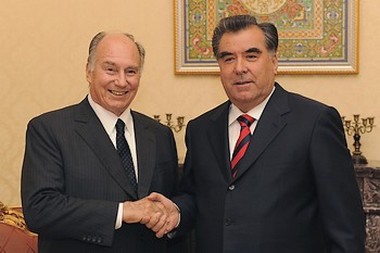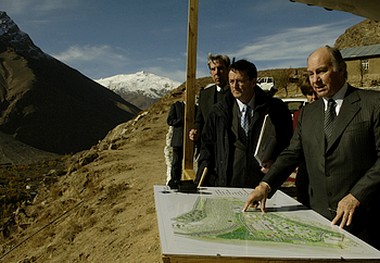A Bridge Over Troubled Waters - Aga Khan's Philanthropy in Tajikistan - 2010-09-22
In Tajikistan, the Aga Khan’s philanthropy and investment has raised hospitals, hotels, colleges, crops – and in some quarters, suspicion. This is the fifth story in a series of articles on philanthropy in TOL’s coverage area.
DUSHANBE | On a sunny day in late October 2006, Shah Karim al-Hussayni, better known as the Aga Khan IV, stepped on to the newly built Ishkashim Bridge over the Panj River and made a speech that was heard simultaneously in Tajikistan and Afghanistan, the countries on either side.
Bridges are powerful symbols, the imam of the world’s Ismaili Muslims said as he opened the span, the fourth built across the Panj by his Aga Khan Development Network (AKDN). “When harmony breaks down and conflicts ensue, destroying bridges is usually among the most urgent targets. But when peace and healing come, then it is the construction and rehabilitation of bridges that marks our progress.”
The Tajik songwriter Lidush Habib has likened the Aga Khan himself to a bridge, connecting the shores of Islam and the West, Asia and Africa, rich and poor. Known in the West not just as a spiritual leader but as a philanthropist, horse breeder, and one-time stepson of 1940s Hollywood star Rita Hayworth, the Aga Khan is revered by many Tajiks for his massive aid to the country during the period of civil conflict, economic collapse, and widespread starvation in the 1990s.
In Badakhshan province, to which the Aga Khan sent hundreds of tons of food, clothes, and medicine to poor locals and refugees during the civil war, grandmothers tell children bedtime stories about angels sent by the imam to carry suffering people from the bloody battlefields into the Pamir Mountains. In Dushanbe and Khorugh, drivers display his picture on their cars. When he comes to Tajikistan, people gather in the streets by the thousands and try to kiss his hand.
“Tajiks are really grateful to the Aga Khan,” said Marat Mamadshoev, editor-in-chief of the Tajik news agency Asia-Plus. “He saved thousands of lives during the Tajik civil war in 1992-1997, when many, if not all, Tajik Pamiris fled the scenes of the war and found shelter in the mountainous Badakhshan province.”
Through AKDN – one of the world’s largest development networks with some 60,000 employees and turnover of nearly $2 billion in nonprofit and business activities – and the related Aga Khan Foundation, the Aga Khan has remained a major force in this Central Asian republic, and at times a controversial one. Given that ethnic Pamiris from Badakhshan (officially the Gorno-Badakhshan Autonomous Oblast, or GBAO) figured heavily in the 1990s revolt and that the region has seen flare-ups of separatist activity since, Tajikistan’s political leaders keep a wary eye on his activities there.
There is distrust, too, on the side of the country’s Sunni Muslim majority, many of whom believe the Aga Khan’s philanthropy heavily favors his own Ismaili sect, a branch of Shiism. “He’s giving one or two bags of rice to the Sunni people in Rasht or Khatlon but spending $10,000 to $15,000 to take a Pamiri student to Oxford, preparing cadres for the long-term future,” said Muhammadazim, a student at the Islamic University of Tajikistan, echoing a widely held sentiment among Sunnis here.
Still, it is a topic on which people publicly tread lightly. Of some two dozen people contacted for this article, only a few agreed to speak on the record. Many were suspicious that the story would focus on AKDN failures, or exacerbate sectarian tension, a sensitive issue given Tajikistan’s proximity to Afghanistan and Pakistan. Officially the government cooperates on a number of projects with Aga Khan institutions, and in October President Imomali Rahmon accompanied the imam to open the AKDN-built Ismaili Center in Dushanbe, praising him for his investment in the country.
BUILDING THROUGH BUSINESS
If the Aga Khan is a sectarian figure, it’s hard to imagine a more multicultural and cosmopolitan one. The son of a Pakistani prince and an English noblewoman, he was born in Geneva, raised in Kenya, educated at Harvard, and now lives in France.
His imamate stems from a lineage Ismailis believe goes directly back to Mohammed. Ismailism separated from what is now mainstream Shia in the seventh century, and its practice is less ritualistic than that of most Shiites.
Ismailis make up a small fraction of Tajikistan’s population of about 7.6 million – some 230,000 in the GBAO and several thousand scattered elsewhere in the country, which is about 85 percent Sunni. But many of the world’s 20 million Ismailis, including large communities in Afghanistan, Pakistan, and Iran, consider Badakhshan the spiritual nerve center of the faith. Ancient legend posits the Pamir Mountains as the place Ismailis found shelter after fleeing persecution in Mesopotamia.
The region was the focus of the Aga Khan’s humanitarian efforts during the civil war. Since the 1997 peace agreement between the government and the mainly Islamist opposition, his institutions in the country and across Central Asia (AKDN is also active in Kazakhstan and Kyrgyzstan) have increasingly focused on the emerging private sector, aiming to strengthen free-market values and fill the gaps left by the collapse of the Soviet system.
The vehicles have been varied – urban and rural development programs, microfinance, health care and social services, large-scale construction, civil society projects, and education (including the three-nation University of Central Asia, the world’s first internationally chartered institution of higher learning).
“Philanthropy to me is not an endless distribution of money,” the Aga Khan said in 2002 in Moscow, where he met with Vladimir Putin to discuss opening institutions in Muslim regions of Russia. The goal of most AKDN initiatives is to develop self-reliant commercial businesses.
According to the AKDN website, private firms founded by the network generate $1.5 billion in revenues a year (the organization says the money is plowed back into further development work). Munir Merali, head of the network in Tajikistan, notes that it has “built several hotels in GBAO and the largest one in Dushanbe” to boost tourism, and launched a telecom that introduced 3G technology to the country.
The network also spent $26.8 million to modernize the Pamir-1 hydroelectric plant and the GBAO’s power grid. While much of Tajikistan suffers winter power shortages, Badakhshan is the only region in the country with uninterrupted electricity supplies year-round.
The potential knock-on effect of both aid and investment is key to AKDN’s work in the area. For example, the Panj River bridges, built with cooperation from the Tajik and Afghan governments, spawned lively markets on both sides, helping reduce food prices in the remote region. Hailing such developments, the Tajik-Afghan interstate economic commission eased cross-border trade restrictions. Last month, visa rules were loosened to allow seriously ill people from Afghanistan to go to AKDN-funded hospitals and clinics for treatment.
Merali boasts that “practically every project” of the Aga Khan foundation and development network in the country has been successful.
Such a claim is unsurprising coming from the network’s Tajik chief, but noted economist Hojimuhammad Umarov also praises the its effectiveness.
“There are two factors that distinguish these institutions from other international NGOs that are active in Tajikistan,” Umarov said. “First, it is the wise combination of business and philanthropy, and second, the [organization] is built on religious unity.”
A CALLING TO GIVE
While AKDN is secular by its own statutes and takes promoting cultural tolerance as part of its mission, the Aga Khan has explicitly affirmed the organization’s roots in faith. “I am fascinated and somewhat frustrated when representatives of the western world – especially the western media – try to describe the work of our Aga Khan Development Network in fields like education, health, the economy, media, and the building of social infrastructure,” he said in a 2006 speech at a German evangelical academy:
“Reflecting a certain historical tendency of the West to separate the secular from the religious, they often describe it either as philanthropy or entrepreneurship. What is not understood is that this work is for us a part of our institutional responsibility – it flows from the mandate of the office of Imam to improve the quality of worldly life for the concerned communities.”
Those roots can be seen in some AKDN activities. In Tajikistan, the network works most directly with Ismaili villages and towns, and its volunteers on the ground are primarily drawn from the faithful. The health committees AKDN has established in recent years are structured similarly to Ismaili religious organizations.
The network’s close bond with Ismaili communities gives it a measure of independence from central and local governments and allows it to implement its plans more effectively than other international agencies. It has also fostered fears that AKDN has a specifically Ismaili and Pamiri agenda, a perception that touches a nerve among Sunnis.
“The religious violence between Shiites and Sunnis in Iraq and Pakistan is awful. We pray to keep Tajikistan far from these kinds of hatred, but the Shia Ismailis are trying to expose their views more openly, challenging the Sunnis,” said Domullo Mirzo, a Sunni worshiper who teaches at the Mavlono Yaqubi Charkhi Mosque in Dushanbe. “For the majority of the Tajik population Ismailis are from a different cultural and historical dimension.”
Over the years the network has sought to address those concerns. In 1998, after several years in which the Aga Khan’s work in Tajikistan consisted primarily of humanitarian aid to Pamiris, opposition and Islamic leaders met with him in Geneva and asked him to broaden his focus beyond Badakhshan. The meeting produced results: the Aga Khan widened the map of his activities to include the Rasht Valley and Khatlon province, two regions also devastated by the civil war. The Aga Khan Microfinance Bank, which opened in 2003 and has given $20 million in loans to thousands of small businesses, has branches in the north of Tajikistan as well as the south, where most of the country’s Ismailis live.
Ashratsho Haqdadshaev, an Ismaili pastor in Khorugh, quotes a fatwa issued by the Aga Khan calling on his followers to practice religious tolerance. “He asks us to be close to our Sunni brothers, to make our rituals similar to theirs. We decided to pray five times [a day] as Sunnis do, instead of three, as Ismaili belief prescribes,” Haqdadshaev said.
He adds, “There haven’t been any incidents between us, at least so far.”
The hope remains in Tajikistan that, like the bridges he and his organization have built between their country and Afghanistan, between philanthropy and profit, the Aga Khan can build a bridge that links different Muslim communities – and benefits both sides.
Sarvinoz Akram is a pseudonym for a journalist in Dushanbe. Photos by Gary Otte, courtesy of the Aga Khan Development Network.
With Charity Toward Some
The head of a leading Russian charity for charities on the state of post-Soviet giving.
by Andy Markowitz
21 September 2010
Ukraine’s Gift Horse
As the country’s richest man becomes a major philanthropist, many question his motives. Other’s say they don’t matter. Third in a series.
by Christine Demkowych
16 September 2010
Giving Ground
In the Czech Republic and Slovakia, new technologies that make charity as easy as reaching for your mobile are replacing Western aid as a key philanthropic engine.
by Lucie Kavanova
14 September 2010
Safety Net
A project born on a Bulgarian online forum pioneers crowd-funding to help desperately ill children – and prompts a lax government agency into action.
by Boryana Dzhambazova
13 September 2010
- 12738 reads
 Ismaili.NET - Heritage F.I.E.L.D.
Ismaili.NET - Heritage F.I.E.L.D.
